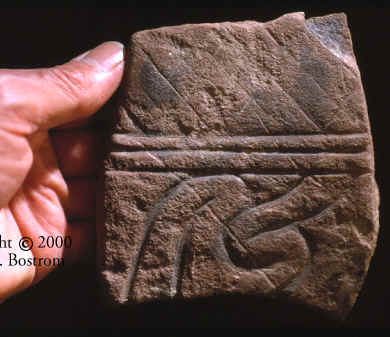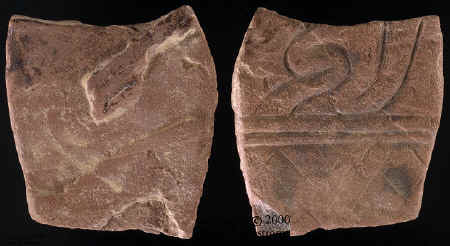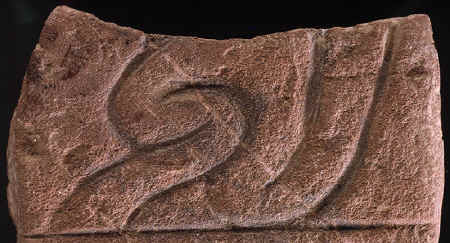|
mississippian
sandstone engraved tablet This engraved tablet recently surfaced when it changed owners. It was surface collected several years ago in a cultivated field in Madison County, Illinois. There are two fairly noticeable "plow marks" on the engraved side, otherwise there does not seem to be any other recent damage. Only one side is engraved, other than for one X design lightly etched near a corner edge on the plain side. The overall color is "reddish" with some darker spots that may indicate it has been heated.
This picture shows both sides of the "Wilson Tablet". It's fairly rough. The outside shape is angled in different directions and not uniformly rectangular like other engraved sandstone tablets from the area. The damage appears to be old. The engraved designs may have been larger at one time but if they were it would be difficult to determine how much larger. Click on the picture to see the single engraved X design at the top left corner on the plain side. This is actually one of the largest tablets from the area. It measures 4 1/4 inches wide and 4 7/8 inches long, about a third larger than the famous "Birdman Tablet" from Cahokia.
The
engraving on this tablet is similar in several ways to other tablets that
have been found in the area around the Cahokia Mounds State Historic Site.
The most common theme on most of these tablets is the diamond
"crosshatching" which this one does have. Although this example
is unique because the crosshatching is shared on the same side with
another design. Almost all other tablets, with the exception of the Ramey
tablet (which is broken--possibly in half), have diamond crosshatching
that covers all of one side only. Another difference is the crosshatching
on this example is very lightly done as compared to most other examples
that are deeply engraved. Some are so deeply grooved that they may have
been used as abraders, possibly for a special purpose.
The Wilson tablet has three parallel lines that separates the two different engraved patterns on opposite ends. Another tablet that has lines that separates different panels is the Ramey tablet which also uses two parallel lines but there are also lines & circles inside of those lines.
The Mississippian culture incorporated many different designs of parallel curving lines in their pottery vessels. The curving line pattern on this stone, although a portion of it appears to have worn away, does seem to relate to Mississippian culture motifs or designs. The curving line pattern on the Wilson tablet may represent an abstract or stylized serpent. Some Mississippian patterns are drawn as serpents with a head and a pointed tail but others are less obvious. All of these various types of patterns are categorized and given names by archaeologist who use them to help interpret archaeological sites. In some cases they can be some of the most important artifacts left behind and can be useful in understanding how cultures interacted on a regional scale. |
|
"REFERENCES" 1898-99,
"Pottery of The Middle Mississippi Valley" 20th Annual Report of
the Bureau of American Ethnology, W. H. Holmes, plates 37, 38 & 53. |




